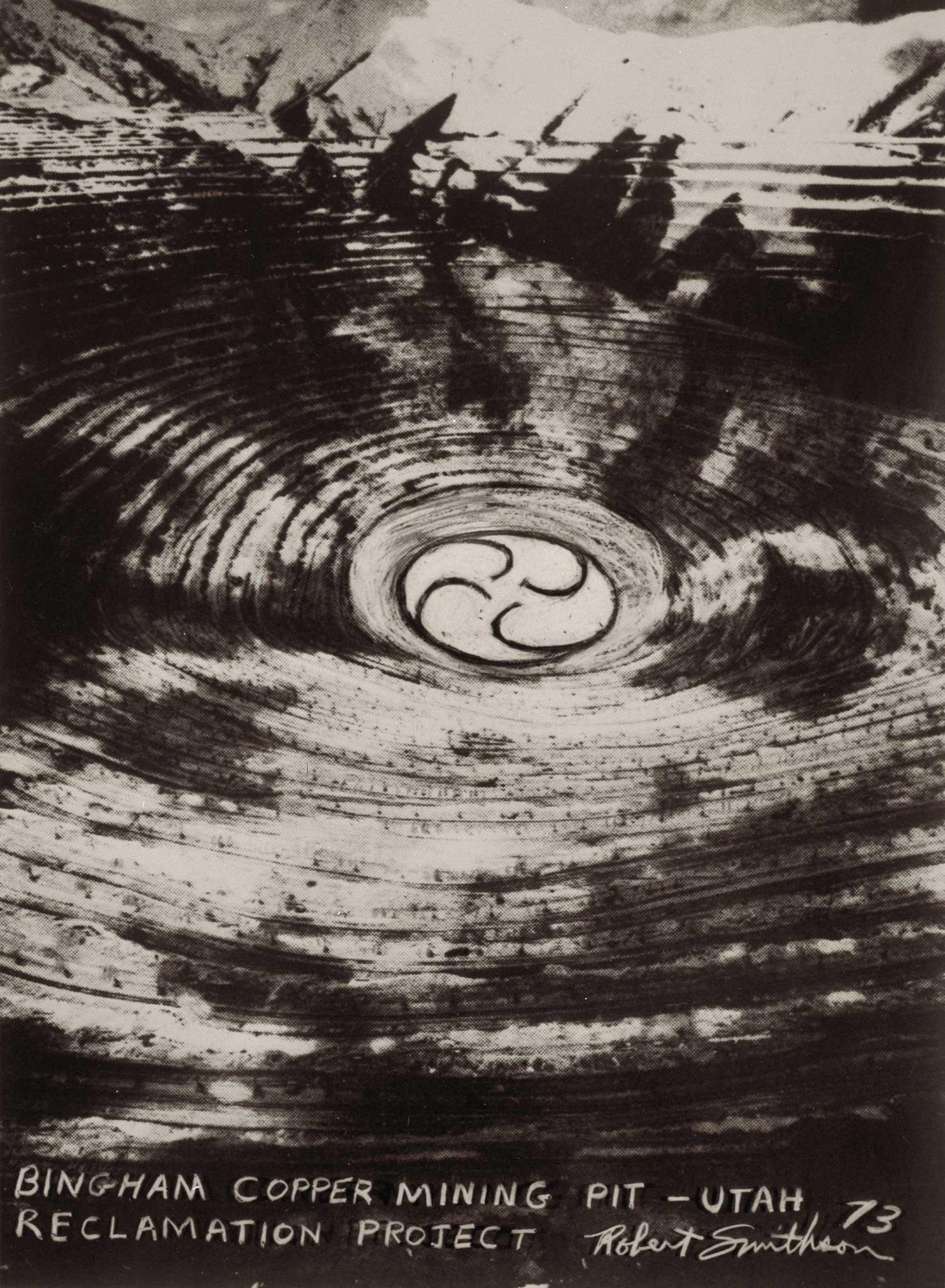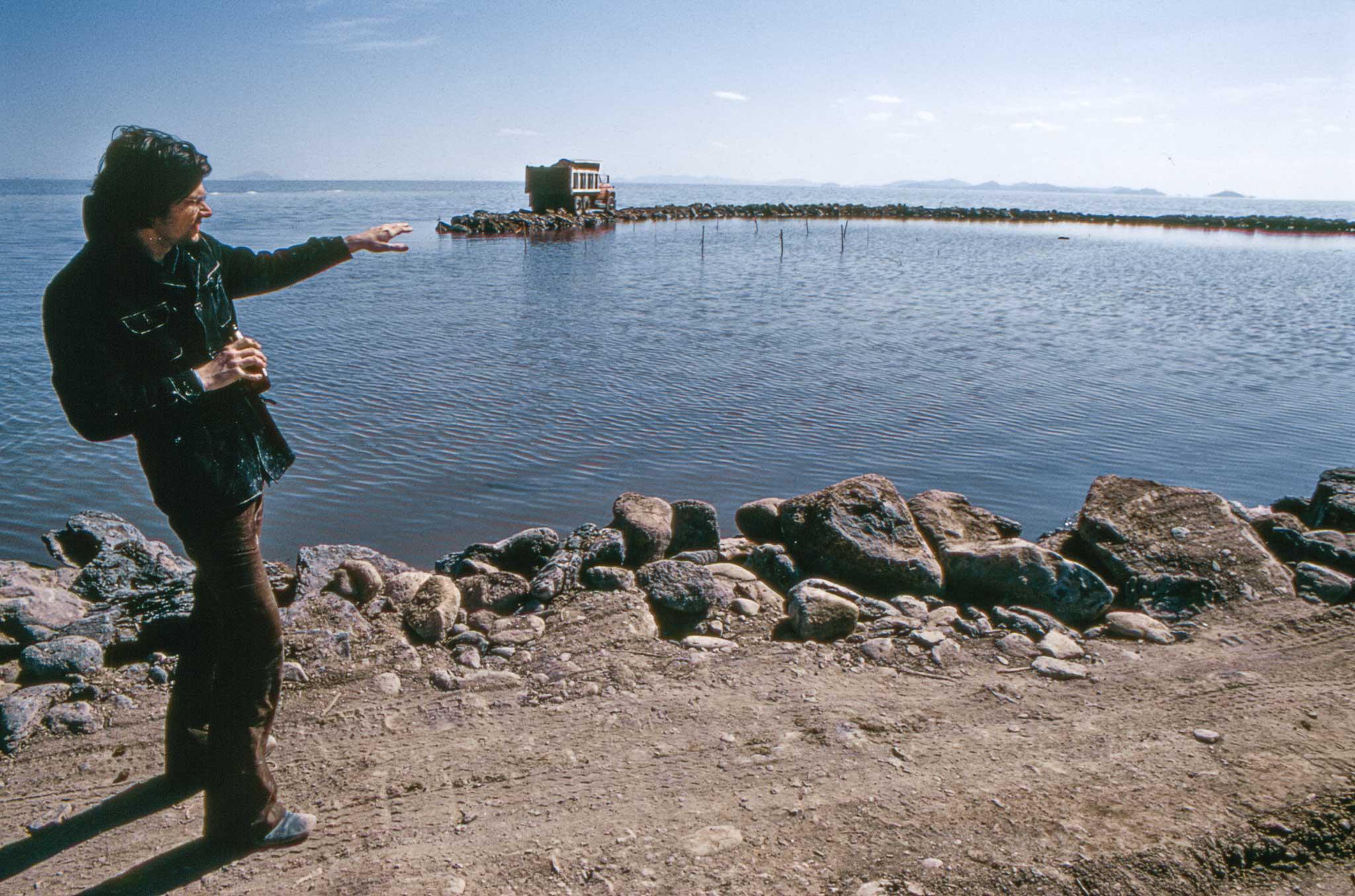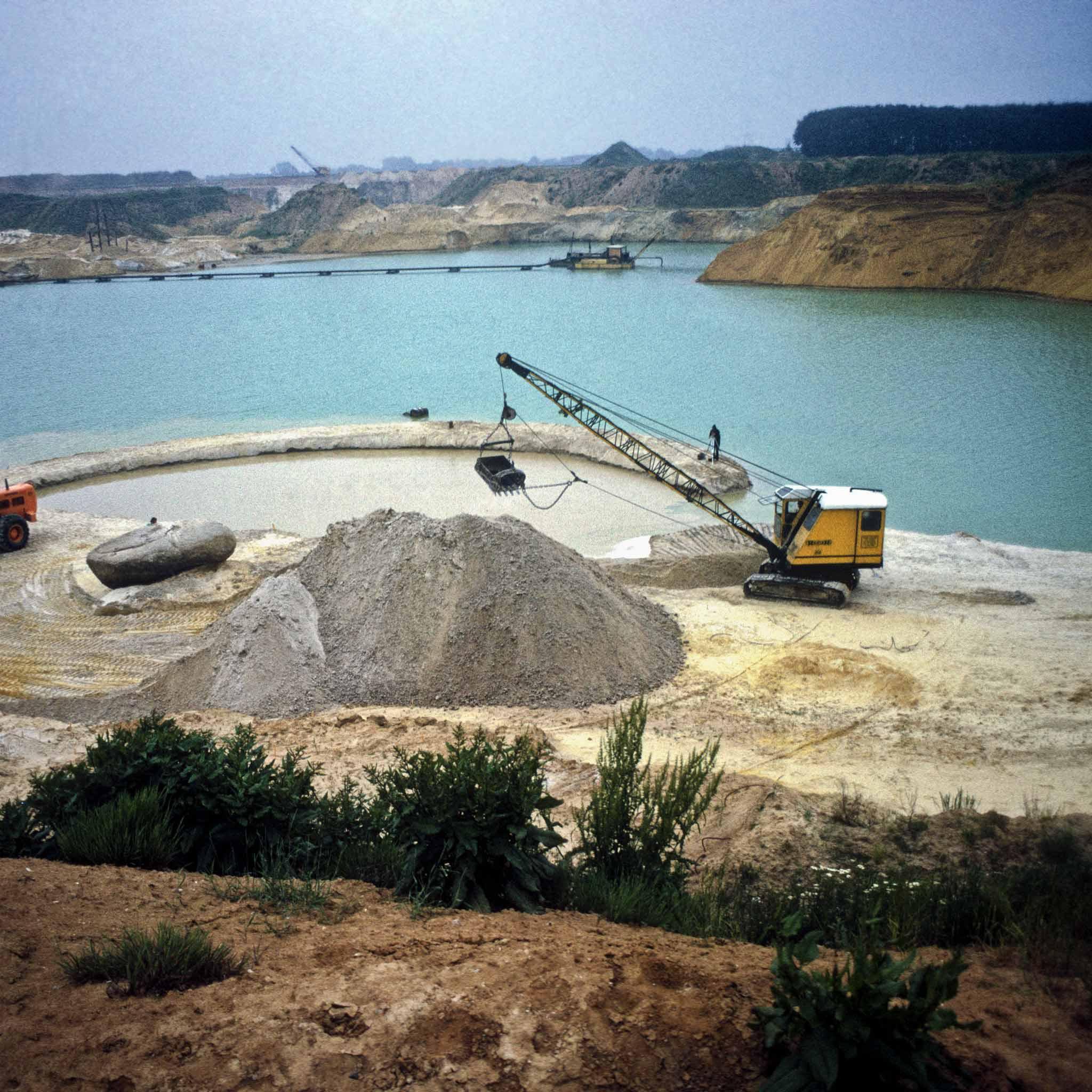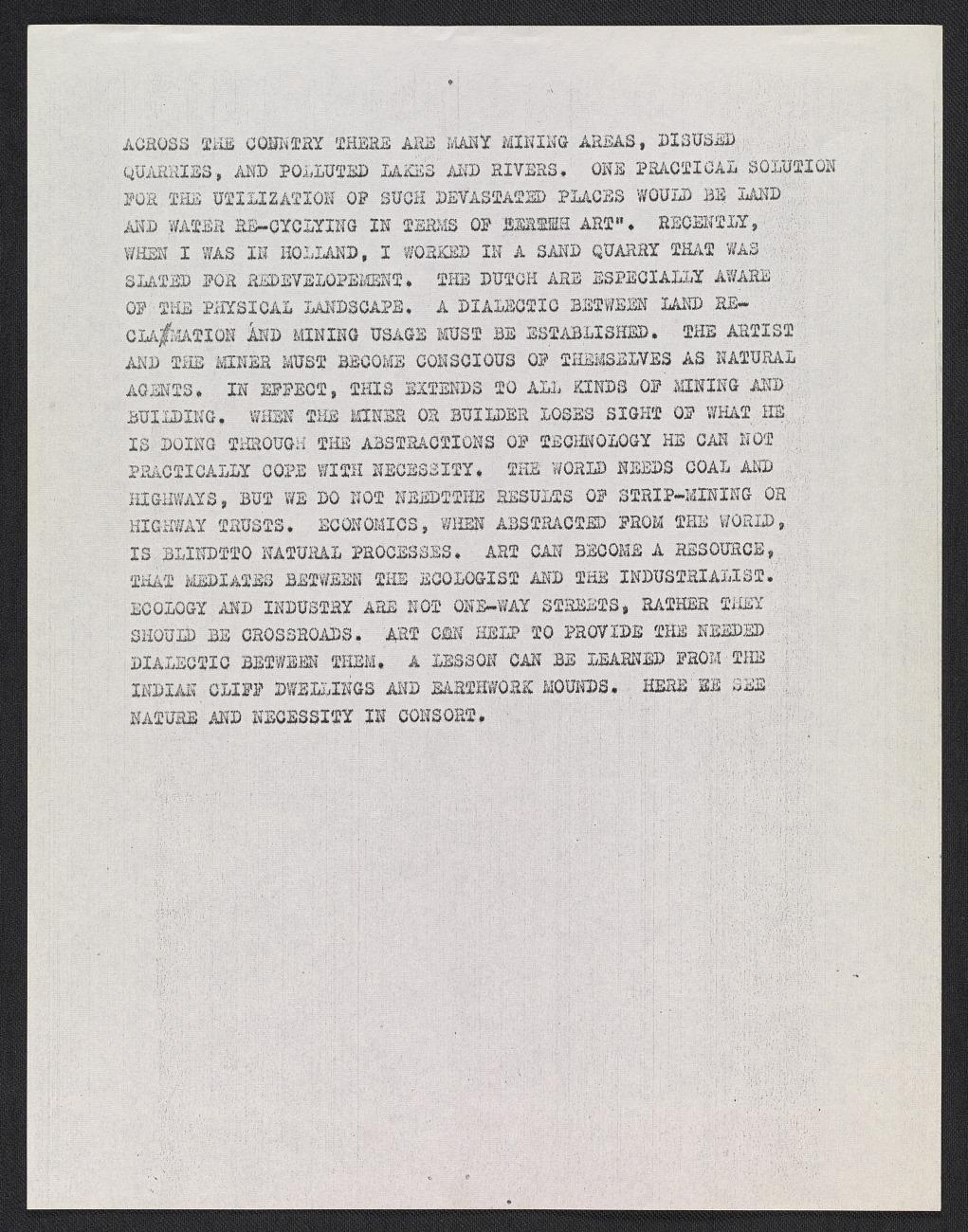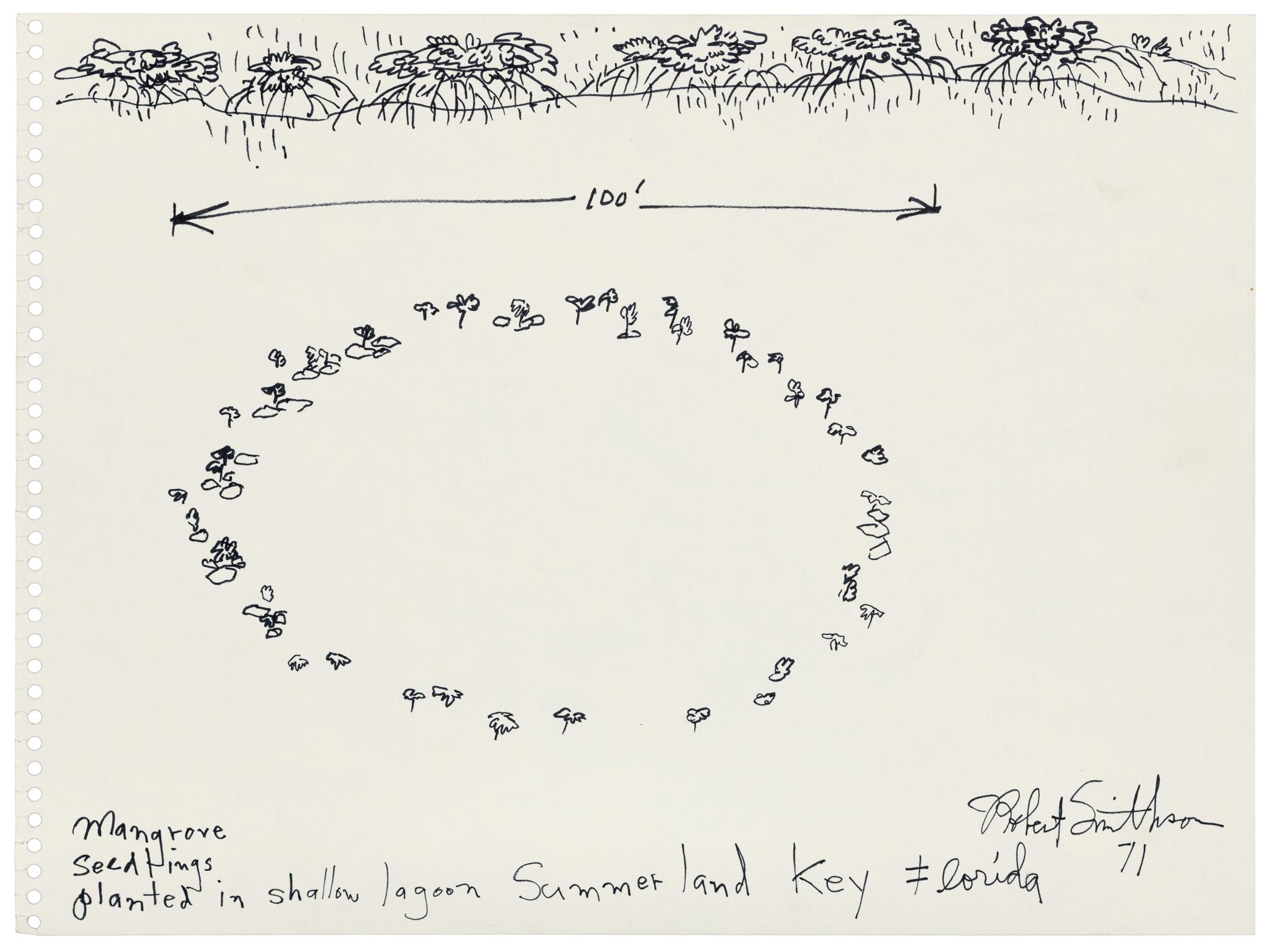Bingham Copper Mining Pit—Utah / Reclamation Project (1973) and Robert Smithson’s “land ethic”
Robert Smithson’s earthworks Spiral Jetty (1970) and Broken Circle /Spiral Hill (1971) are located in sites ravaged by mineral extractions. Both have their origins in the artist’s idea of “entropic landscape,” and are localities where the encounter between two temporalities can be apprehended: geology’s deep time, which has shaped the landscape over millions of years, and the “intensive,” or “superficial,” time of human culture and its extractive processes that revolve and devastate the surface of the Earth in a mere few years.1 Such localities consistently attracted Smithson; he was drawn to quarries and mines from the mid-1960s. The construction of Broken Circle /Spiral Hill in a sand quarry just outside of Emmen in the Drenthe province of the Netherlands consolidated Smithson’s artistic practice as being directly linked to a “land ethic,”2 giving political density to his concept of entropic landscape as an inherent part of modern Western society.
Although his earthworks aesthetically reinforced the entropic condition of the localities in which they were built, with Broken Circle /Spiral Hill Smithson envisioned the possibility of art establishing a dialectical relationship between industrial and environmental interests. At the time a series of environmental laws requiring mining companies recompose the pits created by strip mining were being approved in the United States—pits that were several miles long and deep.3 The artist spent the last years of his life in negotiations with large mining companies to try to put into practice, without success, what he called “land reclamation projects.” Bingham Mining Pit—Utah / Reclamation Project (1973), proposed for Kennecott Copper Corporation’s huge pit of the Bingham Copper Mine in Utah, might be considered the most formalized earthwork proposal of them all. Nevertheless it was never built, was promptly rejected by the mining company, and the ideas it expresses remain only articulated in works on paper.4
In a short untitled text from 1971, written shortly after building his Dutch earthwork, Smithson expresses the dialectic he was seeking to push forward through his land reclamation projects. Directly connected to his land ethics, this idea emerges from his observations on the relation that Western modern society establishes with the land on which it inhabits, uniting it and seeking to compose it with indigenous peoples and cultures, such as the Amerindian ones prior to European occupation. According to Smithson, the construction of earthworks offered a “practical solution for the utilization” of abandoned mining areas and quarries, as well as of polluted lakes and rivers that spread throughout the United States, by “land and water recycling in terms of ‘earth art,’” establishing the necessary “dialectic between land reclamation and mining usage.” Such a practical solution encompasses Smithson’s pragmatic vision of extractivism and its consequent devastation since, in his words, “the world needs coal and highways, but we do not need the results of strip-mining or highway trusts.” The artist also expresses a fundamental notion for him: that Native American practices should serve as lesson in this process, since in their cliff dwellings and earthwork mounds “we see nature and necessity in consort” unlike the search for profit of the extractive processes that go beyond mere necessity.5
Although Smithson states that art as land reclamation has the potential to mediate between environmentalist and industrialist interests, when one analyzes his proposals it is possible to see they are mainly driven by the artistic issues that mobilized him, especially the idea of an entropic landscape which his earlier earthworks stressed.6
With Bingham Mining Pit—Utah / Reclamation Project Smithson makes evident how his reclamation proposals did not seek to conceal the disturbed situation resulting from extractivism, rather to aesthetically reinforce the dialectic between landscape and human culture. As Robert Hobbs states in his study of the artist’s sculptural practice, “Smithson’s work emphasized the changes, establishing and maintaining a dialectic between industrial ravage and bucolic reclamation, acting as a fulcrum to keep in suspension the two opposing states.”7
There is no room for bucolic reclamation in Smithson; for the artist this would be an “attempt to recover a frontier or a wilderness that no longer exists.” Instead, he proposes that we “have to accept the entropic situation” and “more or less learn how to reincorporate these things that seem ugly.”8 It becomes clear, therefore, that there is a distance between his speech to industrialists in his quest to convince them to put into practice his land reclamation projects and the aesthetic results of his Bingham Mining Pit proposal. Smithson’s proposed vortex serves to highlight rather than hide the entropic condition.
Furthermore, Smithson’s inclusion of extra-Western humanities and the other-than-human actants is emblematic of his quest for an ethical recomposing of our relationship with the land one inhabits. The artist seeks to align his earthworks with the practices of peoples who have also built huge earthworks, be that in pre-historic Europe or in the Americas before European colonial invasion. As stated above, Smithson understood Native Americans’ earthworks were moved by “necessity,” something he also saw in his land reclamation projects. For Smithson, the indigenous petroglyphs he saw “in the red canyons of the Colorado River” seemed to have had their sites chosen “based on physical needs—hunting and fishing.” For him, unlike high Modernist abstract art, “the petroglyphs were embedded in particular sites and rooted to necessity”9 just as his land reclamation projects in his understanding. Smithson sought to conform a land ethic that originates in the extractive relationship which modern Western society establishes with the ground, while seeking to open it to extra-Western peoples who cultivated very different relations with their surrounding environment. In this sense, one can say that Smithson’s artistic and theoretical production allows us to envision the emergence of a series of pressing issues regarding contemporary artistic and environmental debates.
In the last decades the idea that we live in the “Anthropocene,” a geological epoch imposed on Earth by the part of humanity that drives and profits from extractive activities, has been consolidated and the Earth is now reacting to those disruptive actions caused on the biosphere.10 Such a situation puts in danger all lives on the planet, demanding urgent responses if humanity wants to survive as a species. Following in a Western viewpoint, French thinker Bruno Latour states that “there is nothing more innovative, nothing more present, subtle, technical, and artificial (in the positive sense of the word), nothing less rustic and rural, nothing more creative, nothing more contemporary than to negotiate landing on some ground.”11 Thus, the task of our generation, and subsequent ones, is the repoliticization of our belonging to the Anthropocene’s devasted ground and its landscapes. Understanding our environment as an entropic landscape is a way of opening a different set of relationships. And to land in Latour’s terms will demand that one composes with all the other humanities and non-human agents who share the ground with us.
That was also a message Smithson left for us in his oeuvre and in his land reclamation projects. The project summarized in the drawing Mangrove Seedlings planted in shallow lagoon, Summerland Key Florida (1971) and registered in Nancy Holt’s film Mangrove ring: Summerland Key Florida (1971), for example, emerges as a cooperative piece between the artist and the plant species arranged in a rational geometrical form. Similarly, in a land reclamation project for Hanna Mining Company, the artist proposed the use of crown vetch to recompose and consolidate the earth structures, pursuing another inter-species cooperation.12 It is possible to see that Smithson’s production, which departs from exploring entropic landscapes, turns into a quest on how to deal with this devasted land resulting from Western extractive activities in the best possible terms, without disregarding such devastation, but trying to diminish its environmental impacts nonetheless. In this way, it would be an early attempt to go against the “rootlessness” which characterizes Western society since the second half of the twentieth century, as stated by Hobbs.13
In Smithson’s land reclamation projects, one can envision the emergence of the Anthropocene as the landscape of our time and ways to deal with its catastrophic consequences. He proposes a cooperation between extra-Western humanities and non-human actants from his standpoint as a white Western male artist working within the artistic and institutional limits of his time. Moreover, his earthworks in general and his land reclamation projects specifically, are ways of escaping from the “cultural confinement” imposed by the art system which Smithson denounced in his text of the same name from 1972. Hence, his land ethic can guide us in this beginning of the twenty-first century, when the need to land in a ground and compose with other terrestrial actants is ever more urgent for the survival of all critters on Earth.
Selected Bibliography
Smithson, Robert. “Proposal” (1972), in Robert Smithson: The Collected Writings, ed. Jack Flam. Berkeley: University of California Press, 1996, 379-380
Smithson, Robert; Sky, Alison. “Entropy Made Visible”, in Robert Smithson: The Collected Writings, ed. Jack Flam. Berkeley: University of California Press, 1996, 301-309
Hobbs, Robert. Robert Smithson: Sculpture. Ithaca: Cornell University Press, 1981
Latour, Bruno. Down to Earth: Politics in the New Climatic Regime. Cambridge: Polity Press, 2018
Morris, Robert. “Notes on Art as/and Land Reclamation”. October, spring 1980, v. 12, 87-102
About the author
André Leal is an architect and urbanist who graduated from the University of São Paulo, and who has a Masters and PhD in Visual Arts from the Federal University of Rio de Janeiro. In his doctoral thesis he researched the concept of the entropic landscape in Robert Smithson’s oeuvre. Leal works as independent critic and curator, has organized exhibitions in Rio de Janeiro, São Paulo and Lisbon, among other cities; he is co-manager of independent artistic space tipografia219 in Rio de Janeiro’s port region and is a member of the Red de Investigadores of the Museo de la Solidaridad Salvador Allende, Santiago, Chile.
- 1This definition of entropic landscape was developed in my PhD thesis: Leal, André. Uma toda-englobante mesmice: paisagens entrópicas de tempos urbanizados (tese de doutorado). Leal, André. An all-encompassing sameness: entropic landscapes of urbanized times (PhD thesis). Rio de Janeiro: PPGAV/EBA/UFRJ, 2022
- 2Smithson, Robert. “Cultural Confinement” (1972), in Robert Smithson: The Collected Writings, ed. Jack Flam. Berkeley: University of California Press, 1996, 155
- 3For an overview of the relationship between art and mining in the 1970s see: Morris, Robert. “Notes on Art as/and Land Reclamation”. October, spring 1980, v. 12, 87-102. In this text, in addition to criticizing Smithson’s proposals, Morris presents in detail the legislative processes regarding land reclamation in mining areas.
- 4Hobbs, Robert. Robert Smithson: Sculpture. Ithaca: Cornell University Press, 1981, 224
- 5Smithson, Robert. “Untitled” (1971), in Robert Smithson: The Collected Writings, 376
- 6
According to Smithson, with Broken Circle/Spiral Hill he “somehow reorganized a disrupted situation and brought it back into another kind of shape. The quarry itself was surrounded by a whole series of broken landscapes, there were pasture lands, mining operations, and a red cliff—it was a kind of sunken site”. Smithson, Robert; Müller, Gregoire. “...The Earth Subject to Cataclyms is a Cruel Master”, in RSCW, 253
The artist expresses Spiral Jetty’s relation with its surrounding landscape in similar terms; see: Smithson, Robert. “The Spiral Jetty” (1972), in RSCW, 143-153
- 7Hobbs, Robert. Robert Smithson: Sculpture, 219
- 8Smithson, Robert; Sky, Alison. “Entropy Made Visible,” in Robert Smithson: The Collected Writings, 307
- 9Smithson, Robert; Müller, Gregoire. “...The Earth Subject to Cataclyms is a Cruel Master,” 255
- 10Philosopher Déborah Danowski and anthropologist Eduardo Viveiros de Castro state in their book The ends of the world that the Anthropocene has given way to ‘the intrusion of Gaia’ in political and social debates. The expression is from Isabelle Stengers, as cited by the authors, and Danowski and Viveiros de Castro affirm that the most significant phenomenon of early twenty-first century is “‘the intrusion of Gaia,’ brusque and abrupt, into the horizon of human history; the sensation of a definitive return of a form of transcendence that we believed transcended, and which reappears in more formidable form than ever. The transformation of humans into a geological force, that is, into an ‘objective’ phenomenon or ‘natural’ object, is paid back with the intrusion of Gaia in the human world, giving the Earth System the menacing form of a historical subject, a political agent, a moral person.” Danowski, Déborah; Castro, Eduardo Viveiros de. The Ends of the world. Cambridge: Polity Press, 2017, 14
- 11Latour, Bruno. Down to Earth: Politics in the New Climatic Regime. Cambridge: Polity Press, 2018, 53
- 12Hobbs, Robert. Robert Smithson: Sculpture, 218
- 13In Hobbs’ words: “Smithson’s main contributions to art lie in his realistic assessment of mid-twentieth-century life. In an era of rootlessness, massive reordering of the landscape, large-scale temporary buildings, and media explosion, he viewed people’s essential apprehension of the world as a rejection of it. [...] In Smithson’s art one thing refers to another, isolation is broken down as connections are taken over.” Hobbs, Robert. Robert Smithson: Sculpture, 15-16
Leal, André. "'Bingham Copper Mining Pit—Utah / Reclamation Project' (1973) and Robert Smithson’s 'land ethic.'" Holt/Smithson Foundation: Scholarly Texts Chapter 4 (October 2022). https://holtsmithsonfoundation.org/bingham-copper-mining-pit-utah-reclamation-project-1973-and-robert-smithsons-land-ethic
